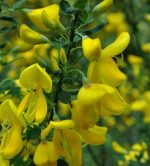 Scotch broom is a deciduous to evergreen, nitrogen-fixing shrub growing 4-8’ tall and is member of the pea family, Fabaceae, that also includes lupine, mimosa, and black locust. It is native to dry, sandy soils in central and western Europe but was introduced into North America as an ornamental in the 1800s, has naturalized and become invasive in disturbed sites in California, Oregon, and Washington in the West and Maine to Alabama in the East. Its success is due to prolific seed production, long viability of seeds, green stems that allow photosynthesis all year around, and the nitrogen-fixing bacteria in its roots that enrich nutrient poor soils. The trifoliate leaves are sparsely distributed on slender branches and have ½” long leaflets. The bright yellow flowers are fragrant, up to 1” long and give way to flattened, pea-like green pods up to 2” long. When the pods are mature they are brown to black and explosively eject their seeds. Several cultivars are available varying most significantly in flower color. The genus name, Cytisus, comes from the Greek word kytisos, that referred to several kinds of woody legumes. The specific epithet, scoparius, comes from the Latin word scopa meaning broom.
Scotch broom is a deciduous to evergreen, nitrogen-fixing shrub growing 4-8’ tall and is member of the pea family, Fabaceae, that also includes lupine, mimosa, and black locust. It is native to dry, sandy soils in central and western Europe but was introduced into North America as an ornamental in the 1800s, has naturalized and become invasive in disturbed sites in California, Oregon, and Washington in the West and Maine to Alabama in the East. Its success is due to prolific seed production, long viability of seeds, green stems that allow photosynthesis all year around, and the nitrogen-fixing bacteria in its roots that enrich nutrient poor soils. The trifoliate leaves are sparsely distributed on slender branches and have ½” long leaflets. The bright yellow flowers are fragrant, up to 1” long and give way to flattened, pea-like green pods up to 2” long. When the pods are mature they are brown to black and explosively eject their seeds. Several cultivars are available varying most significantly in flower color. The genus name, Cytisus, comes from the Greek word kytisos, that referred to several kinds of woody legumes. The specific epithet, scoparius, comes from the Latin word scopa meaning broom.
Type: Flowering shrub.
Outstanding Feature: Flowers.
Form: Cascading.
Growth Rate: Moderate (cultivars) to rapid (species.)
Bloom: Species yellow: cultivars red, pink, orange, white, lavender, purple and combinations of these colors in spring. Flowers are typical pea family type of flower and are produced on old wood.
Size: 4-8’ H x 3-6’ W.
Light: Full sun.
Soil: Poor soil even sandy or heavy clay; tend to be drought tolerant.
Hardiness: Zones 5/6-8, depending on the cultivar.
Care: Low maintenance; can cut back some growth after blooming but always leave at least some of the oldest stems.
Pests and Diseases: Susceptible to leaf and stem blight; caterpillars.
Propagation: Species reseeds prodigiously; cultivars by cuttings.
Outstanding Selections:
 ‘Lilac Time’: reddish-pink and purple; compact; 2-3’ H and W; USDA Hardiness Zones6-8.
‘Lilac Time’: reddish-pink and purple; compact; 2-3’ H and W; USDA Hardiness Zones6-8.
 ‘Moonlight’ creamy-white or primrose; fast growing to 5-6’ H and W; USDA Hardiness Zones 6-8.
‘Moonlight’ creamy-white or primrose; fast growing to 5-6’ H and W; USDA Hardiness Zones 6-8.
 ‘Pomona’ : orange and apricot flowers; to 5’ T x 4’ W; USDA Hardiness Zones 5-8.
‘Pomona’ : orange and apricot flowers; to 5’ T x 4’ W; USDA Hardiness Zones 5-8.
